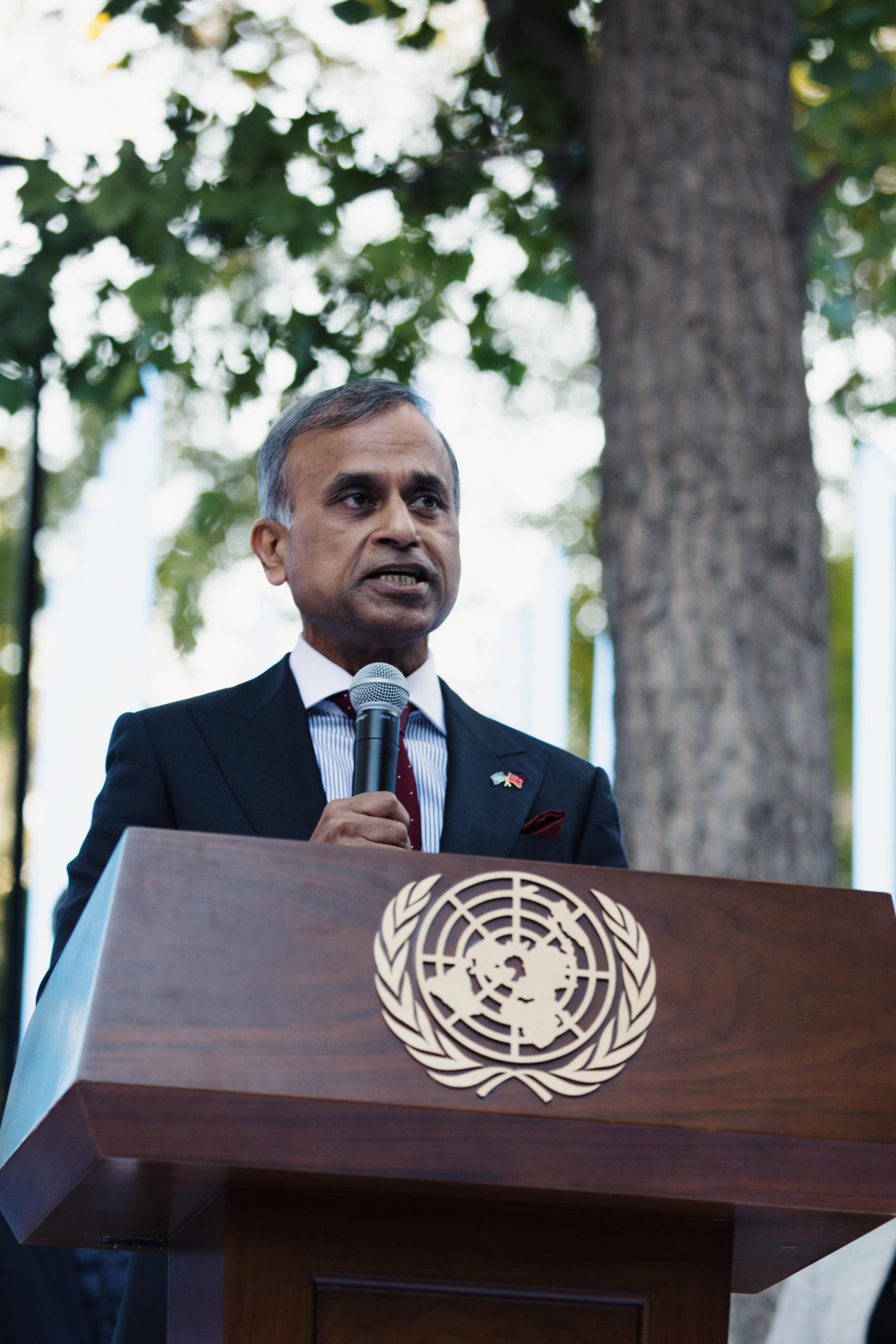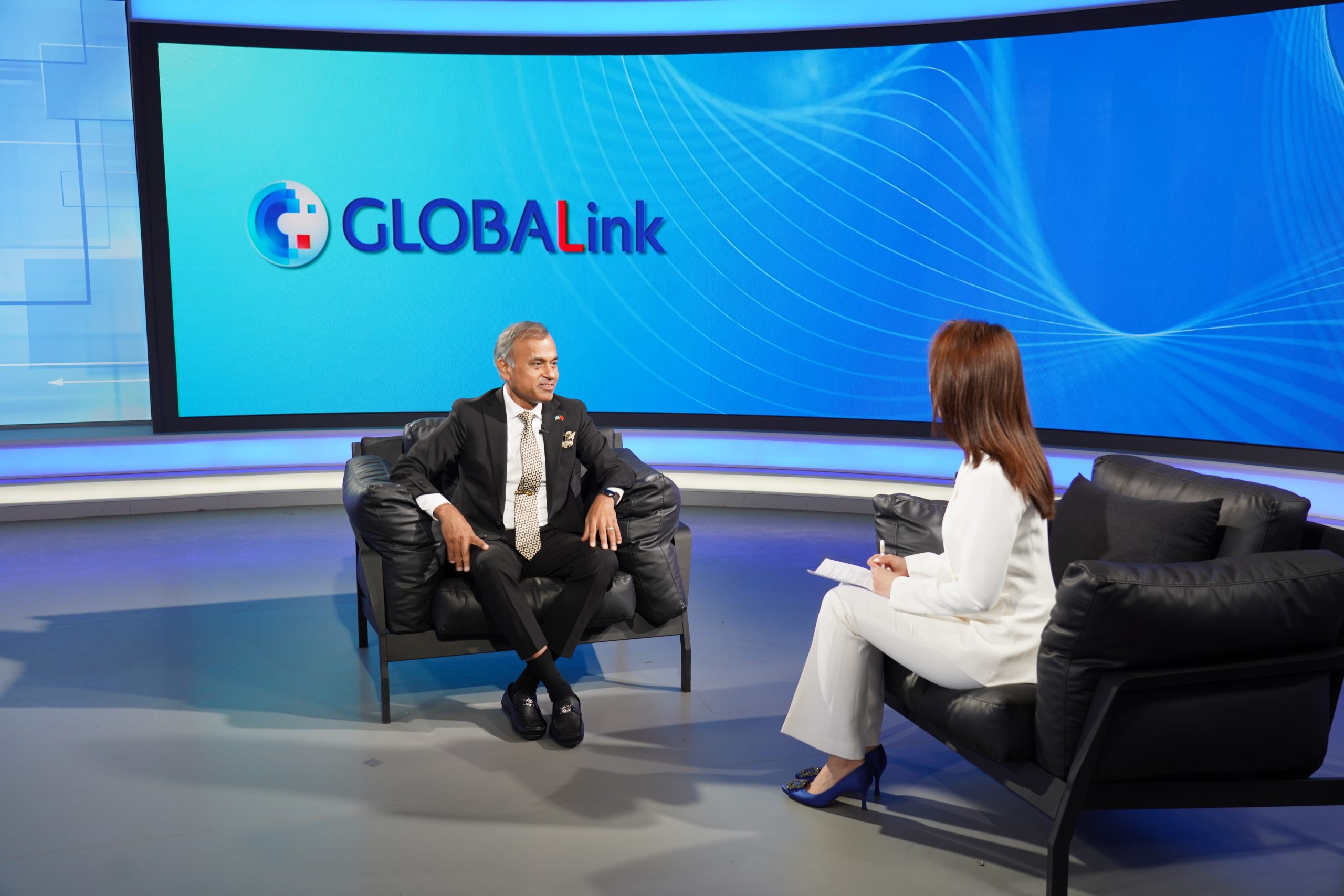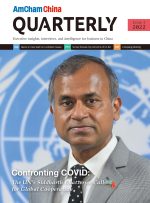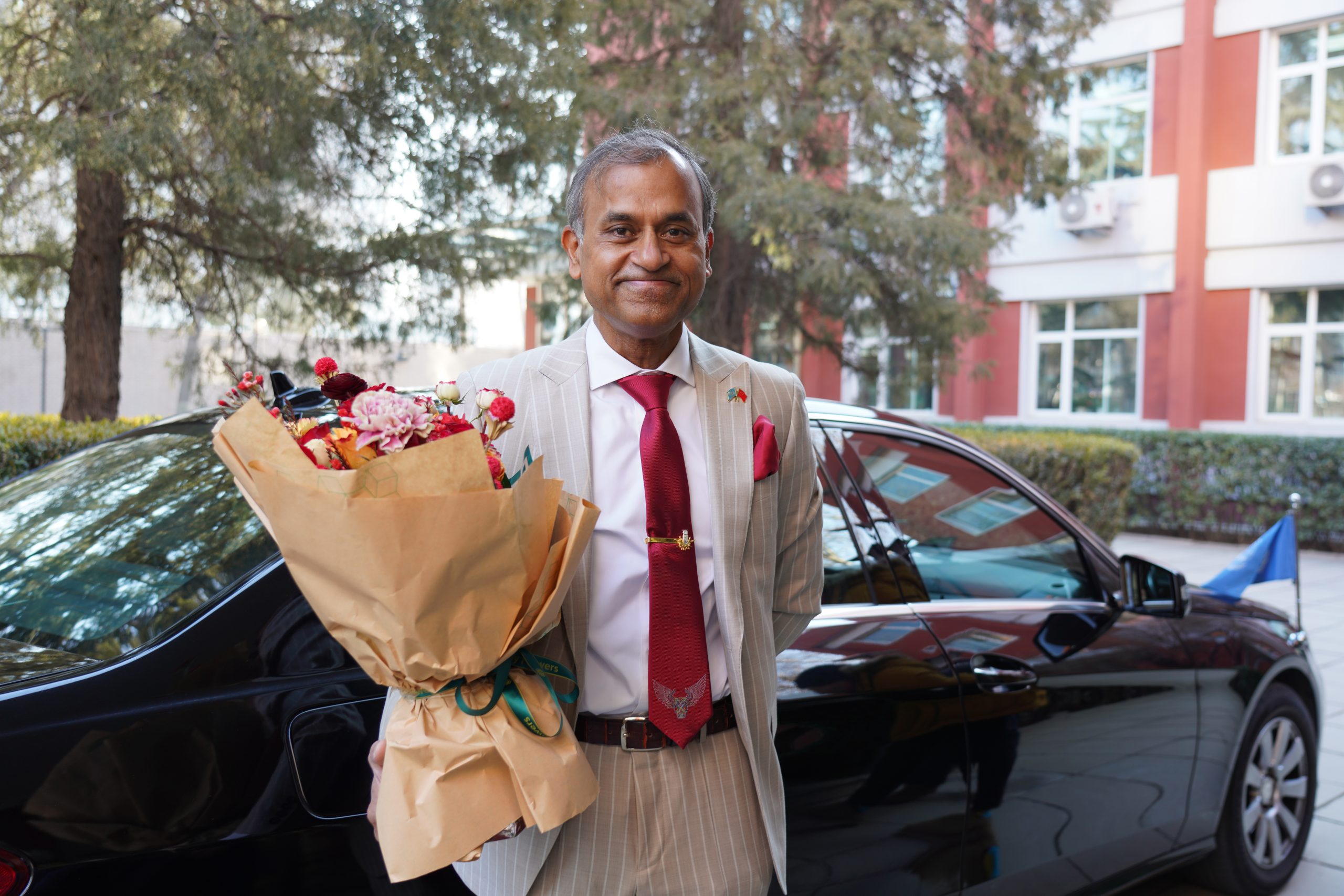Confronting COVID: The UN’s Siddharth Chatterjee Calls for Global Cooperation
By Norris Tangen
As the United Nations Resident Coordinator in China, Sidharth Chatterjee oversees a broad portfolio of issues. But, no issue has been more prevalent over the past two years than the COVID-19 pandemic. The AmCham China Quarterly caught up with Chatterjee about the need for international collaboration to combat the pandemic, vaccine inequality and bottlenecks, and how American and Chinese companies can cooperate to benefit global public health.

Mr. Siddharth Chatterjee took office as the United Nations Resident Coordinator in China on 16 January 2021 and is the designated representative of – and reports to – the UN Secretary-General. He presented his letter of credence to the President of China on 14 April 2021.
Mr. Chatterjee has more than 25 years of experience in international cooperation, sustainable development, humanitarian coordination and peace and security in the United nations and the Red Cross movement. He has served in many fragile and war-torn countries all over the world.
A 3 times TEDx speaker, he is a regular opinion contributor on humanitarian and development issues for a range journals which includes Newsweek, Los Angeles Times, Reuters, Huffington Post, Forbes, CNN, Al Jazeera, the Guardian as well as of late he has also published in mainstream Chinese journals. Mr. Chatterjee holds a master’s degree in public policy from Princeton University in the United States of America.
Photo courtesy of the United Nations
Since taking office as United Nations (UN) Resident Coordinator in China in early 2021 Siddharth Chatterjee has hit the ground running, engaging with municipal and central Chinese government leaders, think tanks, Embassies, and Chambers of Commerce to advocate for the UN’s priorities in China. He has spoken on a broad portfolio of pressing issues from poverty alleviation and zero hunger to climate action, clean energy and good health and well-being.
Recently in July, Chatterjee delivered keynote remarks at AmCham China’s Social Impact Summit. He opened his remarks with an honest assessment of the current global situation, saying, “The world today is at a crucial point of no return as we face a series of global tests. Over two years into the COVID-19 pandemic, we have seen unprecedented socio-economic impacts. In addition, climate change, conflicts, growing inflation, digital divides, rising poverty and hunger, and structural inequalities between and within countries exacerbate the situation while threatening decades of development gains.” Chatterjee went on to say that these global challenges also require global solutions. He praised the US and China for demonstrating good faith collaboration on issues like climate change despite tensions in the bilateral relationship, remarking, “Addressing these global crises requires international cooperation and solidarity, and it is abundantly clear that multilateralism remains our best hope of tackling shared challenges. We are glad to see that despite differences in the bilateral relationship, China and the United States have agreed to collaborate more closely on climate action through the China-U.S. Joint Glasgow Declaration on Enhancing Climate Action in the 2020s, at the 26th Session of the Conference of the Parties to the UN Framework Convention on Climate Change held in Glasgow last year.”
Chatterjee also reaffirmed the UN’s role in serving as a bridge for cooperation, not only between countries and cultures, but through business. He said, “The UN acts as a bridge not only for cooperation among Member States, but also for partnerships between public and private sectors. To deliver on this promise, the UN is finding new ways of working together to build a more networked and ‘fit for purpose’ form of multilateralism, bringing in all sectors of society from all Member States. Leveraging public-private partnerships to make the most of relevant expertise, technology and resources will play an important role. This work is made possible by our colleagues at UN Global Compact.”
Community Center Approaches
Since the COVID-19 vaccines have become widely available in many parts of the world, the UN, and specifically the World Health Organization (WHO), has been spearheading efforts to guarantee vaccine equality for all countries. This, Chatterjee says, is a key area where global cooperation is essential, “The WHO has been front and center in the global effort to deliver science, solutions, and solidarity to end the most acute phases of the pandemic.” And, he says many of their efforts are working, noting that there have been some major successes. However, despite the progress made, Chatterjee says the pandemic still remains an acute global crisis in 2022, “The surge of new cases across the world caused by the spread of the Omicron variant of concern has combined with incomplete vaccination and the lifting of public health and social measures to put health systems and societies under renewed strain.” He goes on, “Our collective failure to vaccinate the vulnerable globally has prolonged the pandemic, with the unacceptable loss of life, health, and global prosperity that entails.”
In March 2022, the WHO released an updated version of their “Strategic Preparedness, Readiness and Response Plan for COVID-19.” Chatterjee notes that this is their third, and, he hopes, final strategic plan for COVID-19, saying that “it could and should be our last.” He shares that the plan outlines the five core components countries should invest in to navigate this acute phase of the pandemic: surveillance, laboratories, and public health intelligence; vaccination, public health and social measures, and engaged communities; clinical care for COVID-19, and resilient health systems; research and development, and equitable access to tools and supplies; coordination, as the response transitions from an emergency mode to long-term respiratory disease management. Beyond these key areas, Chatterjee said the UN will continue to work with all partners to “ensure that the lessons of the past two years are harnessed to drive the works into a new era for pandemic preparedness, readiness and response. COVID-19 has shown that the status quo does not protect our communities, our societies, and our economies.”
In an effort to accelerate the development and manufacture of COVID-19 vaccines and to guarantee fair and equitable access for every country in the world, the WHO launched the COVID-19 Vaccines Global Access (COVAX) Facility along with the Coalition for Epidemic Preparedness Innovations (CEPI), Gavi and key delivery partner UNICEF. Beyond the efforts to ensure equitable access to vaccines, it also works to address vaccine hesitancy, and increase acceptance and demand for COVID-19 vaccinations. In particular, COVAX targets the most at-risk people in society – healthcare workers, the elderly and those with underlying health conditions. Chatterjee says approaches must be tailored to their audiences, “Reasons for low uptake are often very context specific, so we work with countries and partners to thoroughly understand why people might not be motivated or willing to accept or seek vaccination. In many settings, hesitancy is assumed to be the cause of low uptake, but closer study reveals the greater importance of factors such as accessibility, availability and quality of services.” The community too plays an essential role, he says, “Other, social, factors such as personal beliefs and what friends, family and the community believe also have a strong influence.”

Chatterjee sits for an interview with Chinese media
Photo courtesy of United Nations
Vaccine Adoption and Barriers
As many countries globally struggle with vaccine supply and/or hesitancy, China has seen success with the rollout of their two domestic COVID-19 vaccinations. Chatterjee quotes China’s National Health Commission that around 89% of the adult Chinese population in China is fully vaccinated, but he cautions, there is still much to be done in the developing world. Contrasting China’s vaccinated population reaching almost 90%, Chatterjee shares that as of June 2022, only around 13% of the population of low-income countries have been vaccinated with a primary series and only 58 of the WHO’s 195 Member States have reached the 70% target that the COVAX program is targeting by mid-2022.
While there are many reasons behind inequitable vaccination rates, Chatterjee highlights some of the most pressing causes behind the issue. “Three-quarters of the world’s health workers and over-60s have been vaccinated, but the global numbers mask huge disparities between regions and income groups. The most at-risk groups are not optimally protected everywhere: for instance, low-income countries have vaccinated just 23% of their elderly population, and on average, in low-income countries just 37% of healthcare workers have been vaccinated,” he says. Although he goes on to say that despite the bottlenecks in supply, he says that countries that have not reached 70% have still made significant progress on vaccination, especially when one considers how supply was constrained for much of 2021, affecting their ability to scale up supply as efficiently as those with unconstrained supply.
Going forward, Chatterjee says that they must redouble their efforts to control the virus and prioritize those high-risk groups, “We must intensify the efforts to achieve 100% vaccination coverage amongst over 60s, health care workers and people who are immuno-compromised: protecting those at highest risk first is the first step to achieving good levels of vaccine coverage.”
Supporting Vaccination Efforts
The private sector has also played a key role in supporting the WHO’s and COVAX’s aims, Chatterjee shares. The recent focus of the program has been to work with countries to remove barriers to slow implementation of immunization programs. Those barriers include: gaps in planning, coordination and management of immunization programs, in part as a result of unpredictable and uncertain supply; low vaccine confidence, or an adverse event affecting demand, uptake or perception of safety risks of vaccines; insufficient operational funding; product-specific hesitancy; gaps in staffing of immunization programs. Naturally, Chatterjee says that pharmaceutical companies play a pivotal role: “Pharmaceutical companies with product profiles covering vaccines may participate in global public procurement via WHO prequalification with their vaccine products, if they have not done so. Research and development for novel drugs and vaccines and collaboration to support local manufacturing in the global south are areas that companies can do much more to fill in the critical gaps of global health public goods supply.”
Specifically, Chatterjee shares avenues in which AmCham China and its member companies can support the ultimate goal of vaccine equality. He remarks, “In addition, lack of experience and the need for assistance are identified as gaps for Chinese vaccine manufacturers when globalizing their products, therefore it would be valuable to facilitate experience sharing about WHO prequalification application and strategic planning for globalization from AmCham China member companies with Chinese companies. I personally believe American and Chinese companies forging partnerships can have an enduring impact on global health.”

This article is from the AmCham China Quarterly Magazine (Issue 3, 2022). To access the entire publication for free, sign up on our member portal here.

